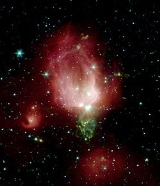
NGC 7129
Encyclopedia
NGC 7129 is a reflection nebula
located 3,300 light years
away in the constellation
Cepheus
. A young open cluster
is responsible for illuminating the surrounding nebula. A recent survey indicates the cluster contains more than 130 stars less than 1 million years old. NGC 7129 is located just half a degree from nearby cluster NGC 7142
.
The nebula is rosebud-shaped; the young stars have blown a large, oddly shaped bubble in the molecular cloud that once surrounded them at their birth. The rosy pink color comes from glowing dust grains on the surface of the bubble being heated by the intense light from the young stars within. The ultra-violet and visible light produced by the young stars is absorbed by the surrounding dust grains. They are heated by this process and release the energy at longer infrared wavelengths as photographed by the Spitzer Space Telescope
. The reddish colors in the false-colour infrared image suggest the distribution of hydrocarbon rich molecular material.
The much cooler molecular cloud outside the bubble is mostly invisible to Spitzer. However, three very young stars near the center of the nebula are sending jets of supersonic gas into the cloud. The collision of these jets heats carbon monoxide
molecules in the nebula. This produces the complex nebulosity that appears like a stem of a rosebud.
Reflection nebula
In Astronomy, reflection nebulae are clouds of dust which are simply reflecting the light of a nearby star or stars. The energy from the nearby star, or stars, is insufficient to ionize the gas of the nebula to create an emission nebula, but is enough to give sufficient scattering to make the dust...
located 3,300 light years
Light Years
Light Years is the seventh studio album by Australian recording artist Kylie Minogue. It was released on 25 September 2000 by Parlophone and Mushroom Records. The album's style was indicative of her return to "mainstream pop dance tunes"....
away in the constellation
Constellation
In modern astronomy, a constellation is an internationally defined area of the celestial sphere. These areas are grouped around asterisms, patterns formed by prominent stars within apparent proximity to one another on Earth's night sky....
Cepheus
Cepheus
Cepheus may refer to:In Greek Mythology:* Cepheus, King of Aethiopia, in Greek mythology* Cepheus, King of Tegea, the king of Tegea, Arcadia in Greek mythologyIn Astronomy:...
. A young open cluster
Open cluster
An open cluster is a group of up to a few thousand stars that were formed from the same giant molecular cloud and have roughly the same age. More than 1,100 open clusters have been discovered within the Milky Way Galaxy, and many more are thought to exist...
is responsible for illuminating the surrounding nebula. A recent survey indicates the cluster contains more than 130 stars less than 1 million years old. NGC 7129 is located just half a degree from nearby cluster NGC 7142
NGC 7142
NGC 7142 is an open cluster about 6,200 light-years away in the constellation Cepheus.-Observational Difficulties:NGC 7142 is located near the reflection nebula NGC 7129, which is a first indication that the cluster may be obscured by an interstellar cloud. Many studies have demonstrated this to be...
.
The nebula is rosebud-shaped; the young stars have blown a large, oddly shaped bubble in the molecular cloud that once surrounded them at their birth. The rosy pink color comes from glowing dust grains on the surface of the bubble being heated by the intense light from the young stars within. The ultra-violet and visible light produced by the young stars is absorbed by the surrounding dust grains. They are heated by this process and release the energy at longer infrared wavelengths as photographed by the Spitzer Space Telescope
Spitzer Space Telescope
The Spitzer Space Telescope , formerly the Space Infrared Telescope Facility is an infrared space observatory launched in 2003...
. The reddish colors in the false-colour infrared image suggest the distribution of hydrocarbon rich molecular material.
The much cooler molecular cloud outside the bubble is mostly invisible to Spitzer. However, three very young stars near the center of the nebula are sending jets of supersonic gas into the cloud. The collision of these jets heats carbon monoxide
Carbon monoxide
Carbon monoxide , also called carbonous oxide, is a colorless, odorless, and tasteless gas that is slightly lighter than air. It is highly toxic to humans and animals in higher quantities, although it is also produced in normal animal metabolism in low quantities, and is thought to have some normal...
molecules in the nebula. This produces the complex nebulosity that appears like a stem of a rosebud.
External links
- http://www.noao.edu/outreach/aop/observers/n7129.html
- "Valentine's Day" 2004 Spitzer Space Telescope press release: the "Cosmic Rose"
- image from the Spitzer Space Telescope
- printable lithograph from the Spitzer Space Telescope

